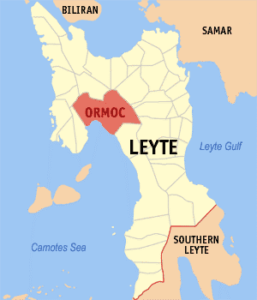 Ormoc City, one of the five independent component cities in the Philippines, is the newest GCoM signatory in the Southeast Asia region to date – officially registered with us in May 2020. With a land area of 613.60 square kilometres, Ormoc City is the largest city in the province of Leyte, located in the region of Eastern Visayas of the Philippines. According to 2015 Census, the number of Ormoc City’s population is 215,031, making it the second-most populous city in the Leyte Province. The city’s terrain is mostly of gently rolling plains; hence it is named after an archaic Visayan term, ogmok, for “lowland” or “depressed plain”[1]. As a port city, Ormoc is the economic, cultural, commercial, and transportation hub of western Leyte.
Ormoc City, one of the five independent component cities in the Philippines, is the newest GCoM signatory in the Southeast Asia region to date – officially registered with us in May 2020. With a land area of 613.60 square kilometres, Ormoc City is the largest city in the province of Leyte, located in the region of Eastern Visayas of the Philippines. According to 2015 Census, the number of Ormoc City’s population is 215,031, making it the second-most populous city in the Leyte Province. The city’s terrain is mostly of gently rolling plains; hence it is named after an archaic Visayan term, ogmok, for “lowland” or “depressed plain”[1]. As a port city, Ormoc is the economic, cultural, commercial, and transportation hub of western Leyte.
Given its geographical location, Ormoc is highly susceptible to natural hazards and extreme weather events – namely typhoons, which occurrence is quite frequent and intense. A number of barangays (villages) in Ormoc located along the shore are also particularly vulnerable to flooding. In the past, there had been two extreme typhoons devastating the Ormoc region: Typhoon Uring (Thelma) in 1991 which caused flash floods in Ormoc Watershed, resulting in 4,000 deaths and leaving 3, 000 families homeless; and Supertyphoon Yolanda (Haiyan) in 2013 which destroyed 30,546 homes and caused a total of 2 billion PhP (40 million USD) damages in agriculture. Upon further assessment and projection, these climate hazards will continue to pose risk for at least 109,880 people along the coast and other areas that are susceptible to geologic hazards of liquefaction and tsunami triggered by earthquakes, potentially causing damages as much as 64.96 billion PhP or around 1.35 billion USD.
In the face of climate change, Ormoc is vulnerable to the impacts it brings. Climate data suggests by 2050 there will be an increase in the city’s precipitation by additional 220 meters and temperature by an additional 2.3°C. This will directly impact the city’s food production, affecting the income of a farmer’s household to a decrease by 2500 PhP or 50 USD. Meanwhile, a threat of urban heat island phenomenon is looming over Ormoc’s urban centers as the temperature is changing due to conventional development that neglects urban vegetation, non-provision of passive cooling, and use of too many concrete materials.
Realising the dire situation, in 2018, the City of Ormoc embarked in an effort to enhance its local climate action plan through a partnership with national agencies such as the Department of Human Settlements and Urban Development, Climate Change Commission, and the Department of Interior and Local Government under the Building Climate Resiliency through Urban Plans and Designs (BCRUPD) Project implemented by UN Habitat. In this project, Ormoc put up a multi-sectoral technical working group that scientifically assesses the climate conditions of the city. The data acquired are used to develop two major assessments – the climate and disaster risk assessment and the greenhouse gas inventory, utilising the tools developed by national agencies. These concerted efforts involved the community, private stakeholders, and multi-level governments which aim for an evidence-based and measurable climate action plan.
From the climate risk assessment of flood, storm surge, rain-induced landslide, and urban heat island, Ormoc City has identified and prioritised climate actions to adapt to the risks which include 6 activities, 3 knowledge base development, 2 support plans, and set of adaptation projects in the natural ecosystem (7), built environment (5), and agriculture (9). Additionally, Ormoc has also determined its greenhouse gas (GHG) emissions baseline in 2017 which amounts to 151,500 tons CO2e. This has guided the city to determine the most suitable mitigation projects to significantly decrease Ormoc’s carbon emissions, namely through the installation of solar panels, deployment of electric vehicles, and pursuing waste to energy technology. The inclusion of vegetation in designing urban spaces, streets, parks, and other open spaces is also being pursued to increase urban carbon sink while aiding in temperature regulation.
Ormoc City has demonstrated its city climate leadership through numerous collaborative initiatives that actively include the communities whose lives are directly affected. Taking the case of Ormoc Urban Waterscape, an adaptation project in Barangay Can-adieng, the people and communities who are direct beneficiaries in this project are involved in the design charrettes and other project development. This project puts forward nature-based solutions in redesigning streets, drains, and parks. The community involvement is engaged more towards the designing of climate-adaptive housing, promoting passive cooling with better air ventilation and circulation, with spaces for urban gardening. In addition to that, the city also encourages the installment of rainwater catchment in the communities’ housing, as a way to use rainfall as a resourceful opportunity, mitigating the climate risk. Ormoc understands that these are not only efforts towards climate adaptation but ultimately an act to ensure people’s safety, health and nutrition, as well as tenure of housing.
Furthering Ormoc’s commitment to a long-term vision towards the goals of the Paris Climate Agreement, the city has recently officiated its Local Climate Change Action Plan for 2019 – 2030 on February 14, 2019. Moving forward, Ormoc is planning to have its climate projects promoted to various national agencies, development partners, and international organizations for funding support. With local partners, the city is exploring partnerships from the traditional development partners such as the Energy Development Corporation and the Ormoc Chamber of Commerce and Industry. Meanwhile, internationally, Ormoc also is also looking forward to accelerating ambitious, measurable climate and energy with GCoM cities across the globe. Through the GCoM platform, Ormoc City is now preparing its first reporting of climate assessment and GHG emission to the CDP-ICLEI unified reporting system. In the near future, Ormoc is eager to compare plans, exchange good practices, and report climate action progress with other GCoM cities for a low-emission and climate-resilient future.
People and communities are at the heart of Ormoc City’s climate action planning. “We believe we have a good baseline for our climate adaptation work that serves as a good basis for our projects and policies. We also believe we have a good number of stakeholders in the private sectors,” added Engr. Raoul Cam, the City Planning and Development Coordinator of Ormoc City, when asked about the potentials of Ormoc City’s climate initiatives. Joining GCoM, Ormoc is willing to showcase the city’s story, share their experiences with other cities worldwide, and is welcome to the possibilities of partnership and supports from future international cooperation.




